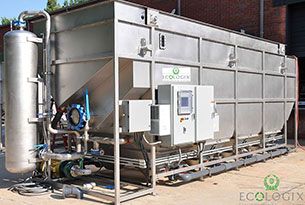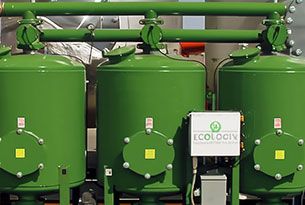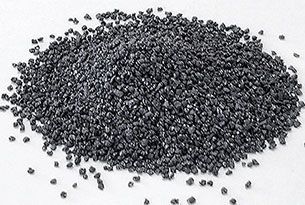Summary
1,2,3-Trichloropropane (1,2,3-TCP, formula C3H5Cl3) is a persistent chlorinated hydrocarbon contaminant from solvent and fumigant uses. Classified as a probable human carcinogen, it requires removal. Granular activated carbon (GAC) adsorption achieves this through high-capacity binding, reducing levels below desired thresholds. Let's take a brief look at 1,2,3-TCP and what we do to remove it.
Table of Contents
Introduction
1,2,3-Trichloropropane is a synthetic chlorinated solvent, colorless to straw-colored with a chloroform-like odor [1]. Used historically for degreasing and as a chemical intermediate in polymers, it persisted as a fumigant byproduct until the 1980s, contaminating groundwater in agricultural areas like California's Central Valley [2] [3].
Ingestion exposure links to carcinogenicity, with animal studies showing tumors in liver, kidneys, and the gastrointestinal tract [4] [5]. The EPA classifies it as likely carcinogenic [6] however there is no federal maximum contaminant level (MCL) as of August 2025. The Fifth Contaminant Candidate List (CCL 5) states preliminary determination is deferred for further data [7] [8]. Several states adopted MCLs including California 5 ng/L, New Jersey 30 ng/L, and Hawaii 600 ng/L [9].
With hydrolysis half-life exceeding 100 years in groundwater, 1,2,3-TCP demands robust treatment [10]. GAC emerges as the proven best available technology (BAT) for effective 1,2,3-TCP removal.
Process Overview
GAC, activated from carbonaceous precursors, provides a high surface area (500-1,500 m²/g) for organic adsorption via van der Waals forces and π-π interactions [10].
As a tertiary polishing step, GAC commonly follows primary and secondary treatments to avoid fouling. Pretreatment is essential to remove total suspended solids (TSS), fats, oils, and grease (FOG), and biochemical oxygen demand (BOD) constituents, which can clog pores, reduce adsorption capacity by 30-50%, and promote biofouling [25] [26] [27]. Coagulation/flocculation, sedimentation, dissolved air flotation (DAF), or multimedia filtration target TSS (>20 μm), FOG (via emulsion breaking), and BOD (via biological oxidation), ensuring influent TSS <5 mg/L, FOG <1 mg/L, and BOD <20 mg/L for optimal GAC performance [28] [29]. Effective pretreatment extends bed life and reduces backwashing.
| Parameter | Influent Limit | Rationale |
|---|---|---|
| TSS | <5 mg/L | Prevents pore clogging |
| FOG | <1 mg/L | Avoids hydrophobic fouling |
| BOD | <20 mg/L | Limits biofouling |
Steps:
- Pretreatment: As above, to protect GAC beds.
- Adsorption: Downflow through fixed-bed columns; empty bed contact time (EBCT) 10-20 min for >95% removal.
- Post-treatment: Effluent polishing if needed; online monitoring via total organic carbon (TOC) analyzers or gas chromatography-mass spectrometry (GC-MS).
- Regeneration: Thermal (steam or inert gas at 800-900°C) or off-site replacement.
GAC is the best available technology (BAT), able to achieve <5 ng/L at effluent [11].
Technical Analysis of 1,2,3-Trichloropropane (TCP) Adsorption
The adsorption of 1,2,3-trichloropropane (TCP) onto granular activated carbon (GAC) is a complex process governed by several key principles: equilibrium, kinetics, and fixed-bed dynamics. These principles are essential for designing and operating effective water treatment systems.
Adsorption Equilibrium and Capacity
Adsorption isotherms describe the relationship between the amount of a substance adsorbed at equilibrium and its concentration in the surrounding solution. The Langmuir and Freundlich models are commonly used to describe this relationship. The Langmuir isotherm is often used for monolayer adsorption and is defined by the equation:
where qe is the adsorbed amount at equilibrium (mg/g), Ce is the equilibrium concentration (mg/L), qm is the maximum adsorption capacity (mg/g), and KL is the Langmuir constant (L/mg).
In contrast, the Freundlich isotherm is an empirical model for heterogeneous surfaces and is expressed as:
where Kf and n are Freundlich constants.
For TCP, granular activated carbon (GAC) derived from coconut shells has shown a maximum adsorption capacity (qm) of approximately 458 mg/g at 30°C. For example, using a Freundlich model with constants Kf=0.2 and n=2, an equilibrium concentration of 0.005μg/L (5x10-6mg/L) would result in an adsorbed amount (qe) of approximately 1.41x10-3mg/g.
Adsorption Kinetics
Adsorption kinetics describe the rate at which an adsorbate is removed from the solution. The pseudo-second-order kinetic model is frequently used to describe the adsorption of contaminants like chlorophenols, including TCP. This model is represented by the equation:
Here, qt represents the amount of adsorbate adsorbed at time t (mg/g), and k2 is the pseudo-second-order rate constant (g/mg⋅min). Typical k2 values for chlorophenol adsorption range from 0.01 to 0.1 g/mg⋅min. At high flow rates, intra-particle diffusion can become the rate-limiting step, slowing down the overall removal process.
Fixed-Bed Adsorber Design and Operation
For continuous water treatment, GAC is typically used in fixed-bed pressure vessels. The performance of these systems is often evaluated using a breakthrough curve, which shows the effluent concentration over time. The Thomas model is a common tool for predicting this behavior:
where Ct is the effluent concentration, C0 is the influent concentration, KTh is the Thomas constant (mL/min⋅mg), q0 is the equilibrium bed capacity (mg/g), m is the adsorbent mass (g), V is the treated volume (mL), and Q is the flow rate (mL/min).
For TCP removal, a breakthrough can occur after treating 50,000 to 150,000 bed volumes, with the exact value depending on factors such as the type of GAC (e.g., bituminous vs. coconut shell-based). [17]
The pressure vessels housing the GAC beds are typically constructed from corrosion-resistant materials like carbon steel (3/16" thick) or stainless steel (304SS/316SS). These vessels can accommodate flow rates from 18 to 1,134 US gallons per minute (GPM), with filtration areas ranging from 1.75 to 50.40 ft2. Key features of these systems include:
- Wedgewire underdrains to ensure uniform flow distribution.
- Automated backwashing to remove trapped solids, which is triggered by a pressure differential or a timer.
- Hydraulic balancing to minimize water waste during the backwash cycle.
Inlet and outlet pipes typically range from 2 to 10 inches in diameter, and backwash flows are between 26 and 189 GPM per tank. These vessels are also designed to support multi-layer media configurations as required.
Design and Performance Parameters for GAC Adsorption
The effective design and operation of a granular activated carbon (GAC) system for contaminant removal, such as 1,2,3-TCP, depend on several critical parameters. These parameters influence the system's capacity, kinetics, and overall efficiency.
Key Design Parameters
Optimal performance is achieved by carefully controlling the physical and hydraulic properties of the GAC bed.
- Empty Bed Contact Time (EBCT): This parameter, calculated as the ratio of the bed volume to the volumetric flow rate is a primary design consideration. A typical EBCT of 10-15 minutes is necessary to ensure adequate contact time for the adsorbate to diffuse into the GAC pores and be removed.
- Bed Depth: A greater bed depth, typically 2-4 meters, is used to increase the overall EBCT. This directly delays the breakthrough of the contaminant into the treated water, extending the service life of the carbon.
- Hydraulic Loading Rate: This is the rate at which water flows through the GAC bed, usually in a downward direction. A rate of 5-10 m/h is a common design standard for GAC pressure vessels.
- Carbon Usage Rate: This metric quantifies the mass of carbon required to treat a given volume of water. The rate, typically 0.1-0.5 g/L treated, is highly dependent on the influent concentration of the contaminant, with higher concentrations requiring more frequent carbon replacement.
Performance and Efficiency
The overall efficiency of the GAC system is influenced by factors beyond just physical design, including pilot-scale testing and the presence of competing substances.
- Pilot-Scale Testing: Rapid Small-Scale Column Tests (RSSCTs) are essential for predicting the performance of a full-scale system. These tests use smaller columns and GAC with a reduced particle size to quickly simulate the breakthrough behavior of a large-scale unit. Scaling factors, such as the particle size ratio, are used to accurately extrapolate the results. [18]
- Removal Efficiency: GAC systems can achieve a high removal efficiency of greater than 99%, typically reducing contaminant concentrations to less than 5 ppt (parts per trillion). [19]
- Competing Factors: The efficiency of GAC adsorption is significantly impacted by the presence of Natural Organic Matter (NOM). NOM, which consists of humic and fulvic acids derived from the decay of plant material, competes for adsorption sites on the carbon surface. This competition can reduce the GAC's capacity for contaminants like TCP by 20-50%. Upstream processes like coagulation or pre-filtration can be used to mitigate the effects of NOM.
- pH Influence: The pH of the water also plays a role in adsorption, with an optimal range of 6-8 typically yielding the best results for GAC performance.
Case Studies
- Tulare, CA: GAC treated 13 wells (influent 10-50 ng/L) to <5 ppt; dual vessels, EBCT 12 min, carbon usage 0.2 g/L [20].
- San Joaquin Winery: GAC columns (0.5 MGD) achieved 98% removal; breakthrough at 100,000 BV [21].
- Honolulu, HI: 60 MGD system; select GACs >150,000 BV to 5 ppt; kinetics favored bituminous carbon [22].
Proposed Visual: Performance Table
| Site | Influent (ng/L) | EBCT (min) | Bed Volumes to Breakthrough | Removal (%) |
|---|---|---|---|---|
| Tulare | 10-50 | 12 | 80,000 | >99 |
| Winery | 20-100 | 10 | 100,000 | 98 |
| Honolulu | 50-600 | 15 | 150,000 | 95-99 |
Challenges
Low-moderate adsorbability (K_oc ~500 L/kg) leads to early breakthrough; NOM competition reduces capacity 30-50%; regeneration efficiency 80-90%, with 10-20% loss per cycle [23].
Solutions
To maximize GAC effectiveness for 1,2,3-TCP removal, select high-mesopore virgin coconut shell-based carbon for improved kinetics and capacity. Implement upstream pre-oxidation with ozone or advanced oxidation processes to break down competing NOM, potentially increasing bed life by 20-50%. While coagulation/flocculation followed by DAF removes 20-50% of NOM—particularly particulate, hydrophobic, and high-molecular-weight fractions—it has limitations with dissolved, hydrophilic, and low-molecular-weight NOM, which can persist at 50-80% of original levels and compete for GAC sites. Ozonation oxidizes this remaining NOM into smaller, more coagulable or biodegradable fragments, enhancing overall removal (additional 6-18% TOC/UV254 reduction) without high doses. For GAC, this minimizes fouling and extends bed life, with ozonation costs (installation $0.5-2M for mid-size plants, operational $0.01-0.05/kgal) often offset by reduced regeneration needs in high-NOM scenarios. Site-specific testing, such as jar tests or pilots, determines if the ROI justifies ozonation. Deploy multi-stage column configurations to distribute loading and delay breakthrough, while leveraging predictive models like ADAM or Thomas for precise system sizing and operation. Regular monitoring and timely regeneration ensure sustained performance, delivering reliable compliance and cost savings over time [24] [31] [32] [33] [34] [35].
Conclusion
GAC adsorption removes 1,2,3-TCP efficiently via isotherm/kinetics-driven processes, achieving sub-ppt levels in wastewater.
Ready to Optimize Your Water Treatment?
Connect with Ecologix Systems today to discuss your specific needs and discover how our advanced solutions can enhance your operations.
Contact Our Experts NowGlossary
- 1,2,3-TCP: 1,2,3-Trichloropropane - A chlorinated hydrocarbon contaminant.
- GAC: Granular Activated Carbon - Porous adsorbent material for organics.
- EBCT: Empty Bed Contact Time - Time water resides in the GAC bed.
- BAT: Best Available Technology - Optimal treatment method per regulations.
- RSSCT: Rapid Small-Scale Column Test - Lab method to predict full-scale performance.
- MCL: Maximum Contaminant Level - Regulatory limit for contaminants in water.
- NOM: Natural Organic Matter - Organic compounds from decayed vegetation that compete for adsorption sites.
- TSS: Total Suspended Solids - Particulate matter in wastewater that can foul GAC.
- FOG: Fats, Oils, and Grease - Hydrophobic substances that reduce GAC efficiency.
- BOD: Biochemical Oxygen Demand - Measure of organic pollution requiring oxygen for degradation.
- DAF: Dissolved Air Flotation - Pretreatment process for removing FOG and TSS.
- TOC: Total Organic Carbon - Indicator for organic content in effluent.
- GC-MS: Gas Chromatography-Mass Spectrometry - Analytical method for detecting trace contaminants.
- K_oc: Organic Carbon Partition Coefficient - Measure of adsorbability to organic carbon.
FAQ
What is the primary mechanism for GAC adsorption of 1,2,3-TCP? GAC primarily uses physisorption, where contaminants bind to the carbon's porous surface through weak van der Waals forces.
Which kinetics model best describes 1,2,3-TCP adsorption on GAC? The pseudo-second-order model is commonly applied, accounting for the rate-limiting chemisorption-like interactions at active sites.
How do engineers predict breakthrough in GAC systems? The Thomas model is widely used to forecast breakthrough curves based on adsorption capacity, flow rates, and bed mass.
How does NOM affect GAC performance, and what can be done about it? NOM competes for adsorption sites, reducing capacity for target contaminants like 1,2,3-TCP; effective mitigation involves pretreatment such as ozonation to degrade NOM beforehand.
Bibliography
- [1] https://en.wikipedia.org/wiki/1%2C2%2C3-Trichloropropane
- [2] https://www.ncbi.nlm.nih.gov/books/NBK464360/
- [3] https://19january2017snapshot.epa.gov/sites/production/files/2014-03/documents/ffrrofactsheet_contaminant_tcp_january2014_final.pdf
- [4] https://www.ncbi.nlm.nih.gov/books/NBK590928/
- [5] https://nj.gov/health/eoh/rtkweb/documents/fs/1902.pdf
- [6] https://iris.epa.gov/ChemicalLanding/&substance_nmbr%253D200
- [7] https://www.federalregister.gov/documents/2025/01/15/2025-00133/announcement-of-preliminary-regulatory-determinations-for-contaminants-on-the-fifth-drinking-water
- [8] https://downloads.regulations.gov/EPA-HQ-OW-2024-0456-0100/attachment_1.pdf
- [9] https://www.sciencepolicyjournal.org/uploads/5/4/3/4/5434385/hauptman_naughton_jspg_19-1.pdf
- [10] https://www.calgoncarbon.com/app/uploads/Calgon_Carbon_123SpecSheet-Final.pdf
- [11] https://www.waterboards.ca.gov/gama/docs/coc_tcp123.pdf
- [12] https://www.sciencedirect.com/science/article/abs/pii/S0269749116310399
- [13] https://jksus.org/?view-pdf=1&embedded=true&article=66c7cdb4659c9f704e6f6f1dcaed8490wetRLzbLUBo%253D
- [14] https://ir.library.oregonstate.edu/downloads/zw12z830b
- [15] https://www.researchgate.net/publication/234104397_Granular_activated_carbon_for_removal_of_organic_matter_and_turbidity_from_secondary_wastewater
- [16] https://www.researchgate.net/profile/Paul-Tratnyek/publication/228485340_Fate_and_remediation_of_1_2_3-trichloropropane/links/0912f50d23137b7aed000000/Fate-and-remediation-of-1-2-3-trichloropropane.pdf
- [17] https://scholarspace.manoa.hawaii.edu/server/api/core/bitstreams/3565b6bb-d810-449d-9083-5beb9272f736/content
- [18] https://repository.lib.ncsu.edu/bitstreams/2de04404-5ea3-4a3a-8067-8a22dc5a6968/download
- [19] https://pmc.ncbi.nlm.nih.gov/articles/PMC11191598/
- [20] https://www.waterboards.ca.gov/drinking_water/certlic/drinkingwater/documents/123-tcp/sbddw17_001/doc%252029.pdf
- [21] https://www.wateronline.com/doc/central-california-winery-removes-tcp-from-well-water-using-granular-activated-carbon-0001
- [22] https://iwaponline.com/washdev/article/11/4/515/81402/Legacy-1-2-3-trichloropropane-contamination-a
- [23] https://escholarship.org/content/qt48f762wt/qt48f762wt_noSplash_b7aef0b3d21d6d6b71c43c184a8fe6fa.pdf
- [24] https://www.researchgate.net/profile/Robert-Clark-10/publication/289507688_EPA%27s_Research_Program_in_Granular_Activated_Carbon/links/5e850d194585150839b59809/EPAs-Research-Program-in-Granular-Activated-Carbon.pdf
- [25] https://lup.lub.lu.se/student-papers/record/9056775/file/9058431.pdf
- [26] https://www.drain-tech.com/blog/reducing-bod-and-tss-in-your-facility-wastewater/
- [27] https://www.ncbi.nlm.nih.gov/books/NBK234593/
- [28] https://www.bondwater.com/daf-issues-chemicals-that-reduce-bod-tss-fog/
- [29] https://www.ssiaeration.com/how-to-reduce-total-suspended-solids-from-wastewater/
- [30] https://ecologixsystems.com/pressure-filters/36-high-multimedia-filtration-systems
- [31] https://www.ncbi.nlm.nih.gov/pmc/articles/PMC9045463/
- [32] https://www.ncbi.nlm.nih.gov/pmc/articles/PMC5949141/
- [33] https://www.sciencedirect.com/science/article/pii/S0043135419303624
- [34] https://pubs.acs.org/doi/10.1021/acs.est.9b05691
- [35] https://www.sciencedirect.com/science/article/pii/S0043135419303624


